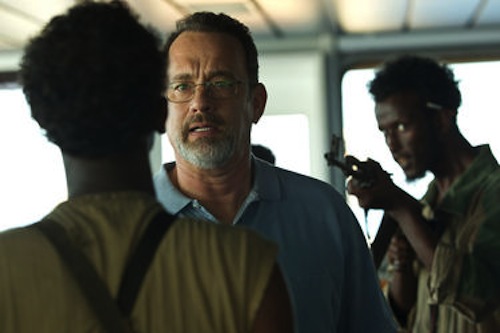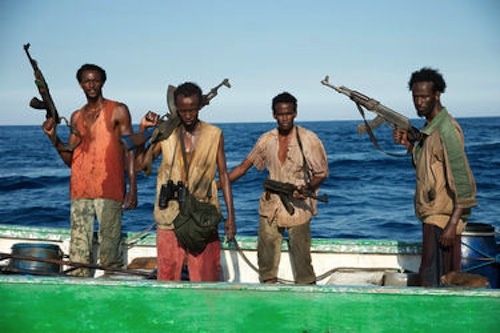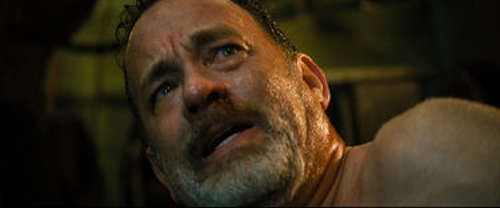Synopsis: Captain Phillips is a multi-layered examination of the 2009 hijacking of the U.S. container ship Maersk Alabama by a crew of Somali pirates. It is – through director Paul Greengrass’s distinctive lens – simultaneously a pulse-pounding thriller, and a complex portrait of the myriad effects of globalization. The film focuses on the relationship between the Alabama’s commanding officer, Captain Richard Phillips (two time Academy Award-winner Tom Hanks), and the Somali pirate captain, Muse (Barkhad Abdi), who takes him hostage. Phillips and Muse are set on an unstoppable collision course when Muse and his crew target Phillips’ unarmed ship; in the ensuing standoff, 145 miles off the Somali coast, both men will find themselves at the mercy of forces beyond their control.
Release Date: October 11, 2013 MPAA Rating: PG-13
Genre(s): Action, Drama
Film Review

Production
Any time there is a heroic or amazing real-life event, it’s only a matter of time before Hollywood cameras roll. In between making Jason Bourne movies, director Paul Greengrass has constructed a bit of a career out of action-oriented biopics, bringing such films as Green Zone, Bloody Sunday, and United 93 to the screen. His latest true-life hero flick is the story of a commercial ship skipper who fought off a pirate attack called Captain Phillips.
Tom Hanks (Cloud Atlas) stars as the titular Captain Rich Phillips, the captain of the Maersk Alabama freighter. While transporting a load of shipping containers off the coast of Somalia, Phillips and his ship are approached by a group of teenaged pirates in an outboard skiff. With no weapons onboard, Phillips instructs his crew to fend off the pirates with fire hoses, but the bandits are able to board the ship. Phillips then sends his crew below deck to the engine room, where they will be out of harm’s way and he can deal with the pirates himself. Phillips goes to great lengths, even allowing himself to be taken as a hostage, in order to prevent his crew from being hurt or killed, but who will save Captain Phillips?

The screenplay for Captain Phillips was written by Billy Ray (The Hunger Games), adapted from the bestseller “A Captain’s Duty: Somali Pirates, Navy SEALS, and Dangerous Days at Sea” by the real Phillips and his co-author Stephan Talty. The events of the film seem to follow the historical accounts fairly accurately, so the outcome of the ordeal is basically known to the audience. This fact makes the use of foreshadowing all the more eerie – when he first arrives on the ship, Phillips finds the pirate boarding cages unlocked, and is shown reading an email that warns of pirate activity in the area through which they’ll be cruising. In the case of Captain Phillips, knowledge of the event doesn’t take away from the suspense that Greengrass is able to generate, it only shifts the priorities; the viewer knows what’s going to happen, but is dying to find out how.

Although there is plenty of seafaring action in Captain Phillips, it’s also a surprisingly insightful character study. As expected, the protagonist is Phillips, and Hanks does a good job at making him human yet heroic. The treatment of the pirates is somewhat unexpected, as they are humanized as well. The film throws a sympathetic light onto the men, who are really no more than kids, showing the poverty and oppression that they face at home before they embark on their raid, and giving the audience an idea of the reason for their desperation. The two main pirates, portrayed by first-time actors Barkhad Abdi and Barkhad Abdirahman, even quarrel amongst themselves, disagreeing about their end goal and giving the audience further reason to relate to them. While there really is no ambiguity as to who the heroes and villains are, the antagonists are not faceless, anonymous murderers; they are real people whose desperate times call for desperate measures. It’s an interesting approach to the story, and it’s what makes Captain Phillips more than just another rescue-from-terrorist movie.

Cinematography
The photography in Captain Phillips is approached in two different ways. First off, there are plenty of long, wide angle external shots of the ship, boats, and sea itself. While fun to look at and technically competent, these are little more than establishing shots, giving the audience an idea of where everything is happening. Once the camera starts rolling on the action inside, the cinematography gets much more exciting.

When it comes to the internal sequences, Captain Phillips is shot in a way that makes the audience feel as if they’re at sea with the characters. Paul Greengrass and Cinematographer Barry Ackroyd (The Hurt Locker) use mostly handheld cameras with a ton of camera motion to give the viewer an almost seasick experience. They also utilize generous amounts of close shots, lending a claustrophobic feel to the picture. The film has a gritty realism that gives it a documentary-like quality. While it never feels like actual news footage, the photography reeks of based-on-a-true-story. It makes the already-tense situation seem a hundred times tenser, and keeps the audience from ever getting too comfortable while watching the film. Greengrass knows what he’s doing when it comes to biopics, and he and Ackroyd flex their muscles on Captain Phillips.
Cast and Crew
- Director(s): Paul Greengrass
- Producer(s):
- Screenwriter(s): Billy Ray
- Story:
- Cast: Tom Hanks (Captain Richard Phillips)Barkhad Abdi (Muse)Barkhad Abdirahman (Bilal) Faysal Ahmed (Najee)Michael Chernus (Shane Murphy)
- Editor(s): Christopher Rouse
- Cinematographer: Barry Ackroyd
- Production Designer(s):
- Costume Designer:
- Casting Director(s):
- Music Score: Henry Jackman
- Music Performed By:
- Country Of Origin: USA
